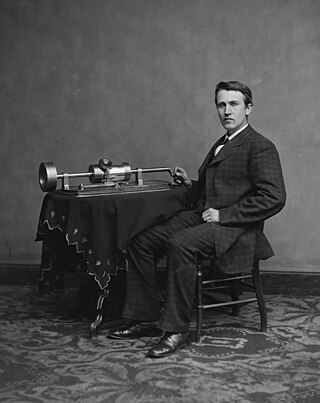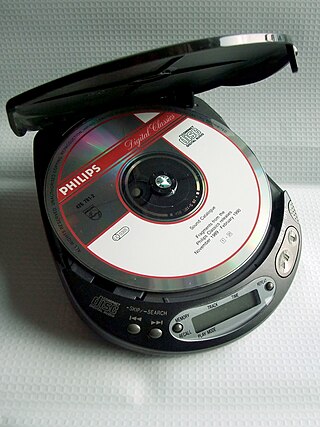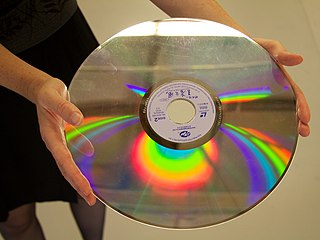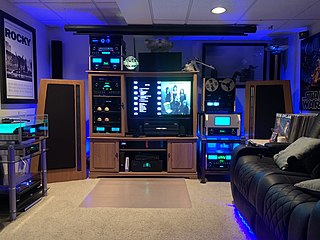Related Research Articles

The compact disc (CD) is a digital optical disc data storage format that was co-developed by Philips and Sony to store and play digital audio recordings. In August 1982, the first compact disc was manufactured. It was then released in October 1982 in Japan and branded as Digital Audio Compact Disc.

A disc jockey, more commonly abbreviated as DJ, is a person who plays recorded music for an audience. Types of DJs include radio DJs, club DJs, mobile DJs, and turntablists. Originally, the "disc" in "disc jockey" referred to shellac and later vinyl records, but nowadays DJ is used as an all-encompassing term to also describe persons who mix music from other recording media such as cassettes, CDs or digital audio files on a CDJ, controller, or even a laptop. DJs may adopt the title "DJ" in front of their real names, adopted pseudonyms, or stage names.

A phonograph, later called a gramophone, and since the 1940s a record player, or more recently a turntable, is a device for the mechanical and analogue reproduction of recorded sound. The sound vibration waveforms are recorded as corresponding physical deviations of a spiral groove engraved, etched, incised, or impressed into the surface of a rotating cylinder or disc, called a "record". To recreate the sound, the surface is similarly rotated while a playback stylus traces the groove and is therefore vibrated by it, very faintly reproducing the recorded sound. In early acoustic phonographs, the stylus vibrated a diaphragm which produced sound waves which were coupled to the open air through a flaring horn, or directly to the listener's ears through stethoscope-type earphones.

Compact Disc Digital Audio, also known as Digital Audio Compact Disc or simply as Audio CD, is the standard format for audio compact discs. The standard is defined in the Red Book, one of a series of Rainbow Books that contain the technical specifications for all CD formats.

A phonograph record, a vinyl record, or simply a record or vinyl is an analog sound storage medium in the form of a flat disc with an inscribed, modulated spiral groove. The groove usually starts near the outside edge and ends near the center of the disc. The stored sound information is made audible by playing the record on a phonograph.

A CD player is an electronic device that plays audio compact discs, which are a digital optical disc data storage format. CD players were first sold to consumers in 1982. CDs typically contain recordings of audio material such as music or audiobooks. CD players may be part of home stereo systems, car audio systems, personal computers, or portable CD players such as CD boomboxes. Most CD players produce an output signal via a headphone jack or RCA jacks. To use a CD player in a home stereo system, the user connects an RCA cable from the RCA jacks to a hi-fi and loudspeakers for listening to music. To listen to music using a CD player with a headphone output jack, the user plugs headphones or earphones into the headphone jack.

A boombox is a transistorized portable music player featuring one or two cassette tape players/recorders and AM/FM radio, generally with a carrying handle. Beginning in the mid 1990s, a CD player was often included. Sound is delivered through an amplifier and two or more integrated loudspeakers. A boombox is a device typically capable of receiving radio stations and playing recorded music. Many models are also capable of recording onto cassette tapes from radio and other sources. In the 1990s, some boomboxes were available with MiniDisc recorders and players. Designed for portability, boomboxes can be powered by batteries as well as by line current. The boombox was introduced to the American market during the late 1970s. The desire for louder and heavier bass led to bigger and heavier boxes; by the 1980s, some boomboxes had reached the size of a suitcase. Some larger boomboxes even contained vertically mounted record turntables. Most boomboxes were battery-operated, leading to extremely heavy, bulky boxes.

Scratching, sometimes referred to as scrubbing, is a DJ and turntablist technique of moving a vinyl record back and forth on a turntable to produce percussive or rhythmic sounds. A crossfader on a DJ mixer may be used to fade between two records simultaneously.

The LaserDisc (LD) is a home video format and the first commercial optical disc storage medium, initially licensed, sold and marketed as MCA DiscoVision in the United States in 1978. Its diameter typically spans 30 cm (12 in). Unlike most optical-disc standards, LaserDisc is not fully digital, and instead requires the use of analog video signals.

A laser turntable is a phonograph that plays standard LP records using laser beams as the pickup instead of using a stylus as in conventional turntables. Although these turntables use laser pickups, the same as Compact Disc players, the signal remains in the analog realm and is never digitized.

An album is a collection of audio recordings issued on a medium such as compact disc (CD), vinyl (record), audio tape, or digital. Albums of recorded sound were developed in the early 20th century as individual 78 rpm records collected in a bound book resembling a photo album; this format evolved after 1948 into single vinyl long-playing (LP) records played at 33+1⁄3 rpm.

The Capacitance Electronic Disc (CED) is an analog video disc playback system developed by Radio Corporation of America (RCA), in which video and audio could be played back on a TV set using a special stylus and high-density groove system similar to phonograph records.

The overwhelming majority of records manufactured have been of certain sizes, playback speeds, and appearance. However, since the commercial adoption of the gramophone record, a wide variety of records have also been produced that do not fall into these categories, and they have served a variety of purposes.
Roksan is a British manufacturer of high fidelity audio products for domestic use, based in Rayleigh, Essex. It is best known for its influential and innovative design for hi-fi equipment, and in particular its Xerxes platform for playing LP records.

Sound recording and reproduction is the electrical, mechanical, electronic, or digital inscription and re-creation of sound waves, such as spoken voice, singing, instrumental music, or sound effects. The two main classes of sound recording technology are analog recording and digital recording.

Vestax Corporation was a Japanese musical instrument, turntable and audio equipment firm founded by Hidesato Shiino in 1977. The company started by designing and manufacturing electronic guitars. In the 1980s, Vestax produced multitrack recorders and later moved to making DJ mixers, professional turntables, CD players and signal processors. Debt troubles led to the company's bankruptcy at the end of 2014.
Stanton Magnetics, doing business as Stanton, is a business unit of inMusic Brands that designs and markets turntables, cartridges, DJ mixers, DJ media players, and DJ controllers.
Elektromesstechnik (EMT) is a manufacturer of phonograph turntables and professional audio equipment, including a well-regarded line of artificial reverberation devices beginning with the EMT 140 plate reverb. The company was founded by Wilhelm Franz.

The LP is an analog sound storage medium, a phonograph record format characterized by: a speed of 33+1⁄3 rpm; a 12- or 10-inch diameter; use of the "microgroove" groove specification; and a vinyl composition disk. Introduced by Columbia Records in 1948, it was soon adopted as a new standard by the entire US record industry. Apart from a few relatively minor refinements and the important later addition of stereophonic sound in 1957, it remained the standard format for record albums, during a period in popular music known as the album era. Beginning in the late 1970s, LP sales began to decline because of the increasing popularity of Compact Cassettes, then in the 1980s of compact discs. By 1988, the latter format began to outsell LPs.

Home audio systems refer to audio consumer electronics designed for home entertainment, such as integrated systems like shelf stereos and music centers, as well as individual components like loudspeakers and surround sound receivers. The evolution of home audio began with Edison's phonograph, transitioning from monaural to stereophonic sound in the 1950s and 60s. The term "hi-fi" emerged, highlighting sound accuracy and minimal distortion. Audio equipment evolved from large wooden cabinets to compact units. The 1970s introduced enhancements like quadraphonic sound and technologies like Dolby Pro Logic. The 1970s and 1980s also saw the rise of component-based stereo systems. Cassette decks became a staple in the 1970s. Integrated systems, termed "music centers" gained popularity in the 1980s. Table systems and compact radio receivers emerged as entertainment devices, with some offering features like cassette players and CD functionalities. Audiophile systems prioritize high-quality music formats and specialized equipment like premium turntables, digital-to-analog converters, and other high-end devices, with some enthusiasts preferring the unique sound characteristics of vinyl records and vacuum tubes. Modern systems often emphasize home cinema applications to enhance the audio experience beyond standard TV speakers.
References
- ↑ "ELP LT-2XRC". zStereo. Retrieved 6 January 2017.
- 1 2 3 4 5 Bill Gaw (April 2004). "Audiolics Anonymous Chapter 55 : ELP Laser Turntable". enjoythemusic.com. Retrieved 13 December 2012.
- ↑ "ELP Laser Turntable". 19 May 2006. Retrieved 13 December 2012.
- ↑ Ralph Glasgal (3 March 2000). "The ELP Laser Turntable". Stereo Times. Archived from the original on 26 November 2012. Retrieved 13 December 2012.